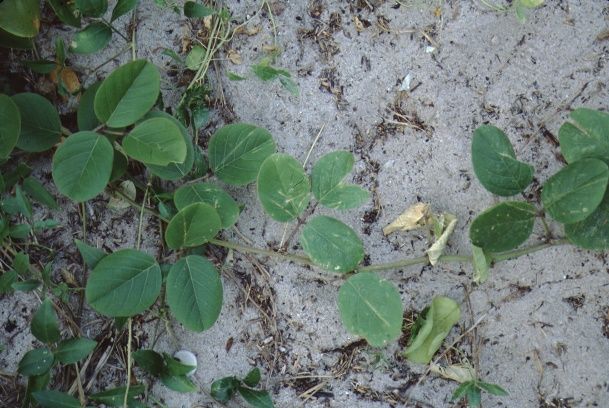Introduction
Beach bean is a dense ground cover that is commonly found in the coastal sands of southeast Florida. This plant forms a ground cover that is 6 to 12 inches in height but can occasionally be found climbing a small tree. The evergreen, trifoliate leaves have elliptic, 2½ to 3½ inch-long leaflets that are rounded at their apices. Small racemes of pink to purple flowers occur among these bright green leaves throughout the year. These beautiful flowers are followed by robust, woody pods.

Credit: Edward F. Gilman, UF/IFAS

Credit: Edward F. Gilman, UF/IFAS
General Information
Scientific name: Canavalia maritima
Pronunciation: kan-uh-VAL-ee-uh muh-RIT-tim-uh
Common name(s): beach bean, bay bean
Family: Leguminosea
Plant type: vine; ground cover
USDA hardiness zones: 10B through 11 (Figure 3)
Planting month for zone 10 and 11: year round
Origin: native to Florida
Invasive potential: not known to be invasive
Uses: cascading down a wall
Availability: grown in small quantities by a small number of nurseries

Credit: undefined
Description
Height: depends upon supporting structure
Spread: depends upon supporting structure
Plant habit: prostrate (flat); spreading
Plant density: open
Growth rate: fast
Texture: coarse
Foliage
Leaf arrangement: alternate
Leaf type: trifoliate
Leaf margin: entire
Leaf shape: elliptic (oval)
Leaf venation: brachidodrome; pinnate
Leaf type and persistence: evergreen
Leaf blade length: 2 to 4 inches
Leaf color: green
Fall color: no fall color change
Fall characteristic: not showy
Flower
Flower color: purple
Flower characteristic: year-round flowering
Fruit
Fruit shape: pod or pod-like
Fruit length: 3 to 6 inches
Fruit cover: dry or hard
Fruit color: brown
Fruit characteristic: inconspicuous and not showy
Trunk and Branches
Trunk/bark/branches: not applicable
Current year stem/twig color: not applicable
Current year stem/twig thickness: not applicable
Culture
Light requirement: plant grows in full sun
Soil tolerances: acidic; slightly alkaline; sand; loam
Drought tolerance: high
Soil salt tolerances: good
Plant spacing: 24 to 36 inches
Other
Roots: not applicable
Winter interest: no special winter interest
Outstanding plant: not particularly outstanding
Pest resistance: no serious pests are normally seen on the plant
Use and Management
This ground cover resists erosion by wind and light surf and is ideal for coastal landscapes. The bright green leaves and showy flowers of this plant are sure eye-catchers. It is a wonderful utility plant for stabilizing sandy soils and makes a nice bed for trees and shrubs. It might climb up onto dense shrubs and the trunks of trees. This could be a maintenance problem for some landscapes.
Beach bean, as the name implies, has a high drought and salt spray tolerance. It prefers well-drained soils and full sun exposures.
Pests and Diseases
No pests or diseases are of major concern.